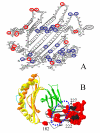The orthology of HLA-E and H2-Qa1 is hidden by their concerted evolution with other MHC class I molecules
- PMID: 16542007
- PMCID: PMC1403747
- DOI: 10.1186/1745-6150-1-2
The orthology of HLA-E and H2-Qa1 is hidden by their concerted evolution with other MHC class I molecules
Abstract
Background: Whether MHC molecules undergo concerted evolution or not has been the subject of a long-standing debate.
Results: By comparing sequences of eight functional homologues of HLA-E from primates and rodents with those of MHC class Ia molecules from the same eight species, we find that different portions of MHC class I molecules undergo different patterns of evolution. By focusing our analyses sequentially on these various portions, we have obtained clear evidence for concerted evolution of MHC class I molecules, suggesting the occurrence of extensive interallelic and intergenic exchanges. Intra-species homogenisation of sequences is particularly noticeable at the level of exon 4, which codes for the alpha3 domain, but our results suggest that homogenisation also concerns certain residues of the alpha1-alpha2 codomain that lie outside the antigen recognition site.
Conclusion: A model is presented in which Darwinian selective pressures due to pathogens could, at the same time, favour diversification of MHC class Ia molecules and promote concerted evolution of separate loci by spreading advantageous motifs arising by mutations in individual MHC molecules to other alleles and to other loci of the MHC region. This would also allow MHC molecules to co-evolve with the proteins with which they interact to fulfil their functions of antigen presentation and regulation of NK cell activity. One of the raisons d'être of the MHC may therefore be to favour at the same time both diversification of MHC class Ia molecules and homogenisation of the whole pool of MHC class I molecules (Ia and Ib) involved in antigen presentation.
Reviewers: This article was reviewed by Stephan Beck, Lutz Walter and Pierre Pontarotti.
Figures






Similar articles
-
Various hypotheses on MHC evolution suggested by the concerted evolution of CD94L and MHC class Ia molecules.Biol Direct. 2006 Jan 31;1:3. doi: 10.1186/1745-6150-1-3. Biol Direct. 2006. PMID: 16542034 Free PMC article.
-
MHC-F polymorphism and evolution.Tissue Antigens. 2007 Apr;69 Suppl 1:136-9. doi: 10.1111/j.1399-0039.2006.763_3.x. Tissue Antigens. 2007. PMID: 17445188
-
MHC-F DNA sequences in bonobo, gorilla and orangutan.Tissue Antigens. 2005 Oct;66(4):277-83. doi: 10.1111/j.1399-0039.2005.00477.x. Tissue Antigens. 2005. PMID: 16185322
-
A structural perspective on MHC class Ib molecules in adaptive immunity.Trends Immunol. 2006 Sep;27(9):413-20. doi: 10.1016/j.it.2006.07.006. Epub 2006 Jul 21. Trends Immunol. 2006. PMID: 16860610 Review.
-
Regulation of MHC II and CD1 antigen presentation: from ubiquity to security.J Leukoc Biol. 2009 Feb;85(2):215-24. doi: 10.1189/jlb.0308206. Epub 2008 Sep 22. J Leukoc Biol. 2009. PMID: 18809734 Review.
Cited by
-
Plasma from stored packed red blood cells and MHC class I antibodies causes acute lung injury in a 2-event in vivo rat model.Blood. 2009 Feb 26;113(9):2079-87. doi: 10.1182/blood-2008-09-177857. Epub 2009 Jan 8. Blood. 2009. PMID: 19131548 Free PMC article.
-
MHC-linked and un-linked class I genes in the wallaby.BMC Genomics. 2009 Jul 14;10:310. doi: 10.1186/1471-2164-10-310. BMC Genomics. 2009. PMID: 19602235 Free PMC article.
-
Primate-specific regulation of natural killer cells.J Med Primatol. 2010 Aug;39(4):194-212. doi: 10.1111/j.1600-0684.2010.00432.x. J Med Primatol. 2010. PMID: 20618586 Free PMC article. Review.
-
Natural Killer T-like Cells: Immunobiology and Role in Disease.Int J Mol Sci. 2023 Feb 1;24(3):2743. doi: 10.3390/ijms24032743. Int J Mol Sci. 2023. PMID: 36769064 Free PMC article. Review.
-
Deregulation of HLA-I in cancer and its central importance for immunotherapy.J Immunother Cancer. 2021 Aug;9(8):e002899. doi: 10.1136/jitc-2021-002899. J Immunother Cancer. 2021. PMID: 34353849 Free PMC article. Review.
References
LinkOut - more resources
Full Text Sources
Other Literature Sources
Research Materials

